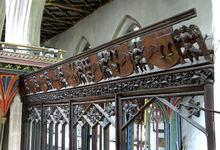
The Cary family is an English aristocratic family with a branch in Ireland. The earliest known ancestor of the family is Sir Adam de Kari who was living in 1198. Sir John Cary purchased the Manor of Clovelly in the 14th century and established the family's status as members of the landed gentry. Various branches of the family were ennobled in the late 16th and early 17th centuries as Baron Hunsdon and Viscount Falkland.

Richard Fortescue of Filleigh, North Devon was an English Member of Parliament and prominent land-owner and member of the Devonshire gentry, ancestor to the Earls Fortescue.

Bradfield House is a Grade I listed country house situated in the parish of Uffculme, Devon, England, 2 miles (3.2 km) south-west of the village of Uffculme.

Robert Carey, lord of the manor of Clovelly in North Devon, was Member of Parliament for Barnstaple, Devon, in October 1553 and served as Sheriff of Devon in 1555–56. He served as Recorder of Barnstaple after 1560. Along with several other members of the Devonshire gentry then serving as magistrates he died of gaol fever at the Black Assize of Exeter 1587. His large monument survives in Clovelly Church.

The landed gentry and nobility of Devonshire, like the rest of the English and European gentry, bore heraldic arms from the start of the age of heraldry circa 1200–1215. The fashion for the display of heraldry ceased about the end of the Victorian era (1901) by which time most of the ancient arms-bearing families of Devonshire had died out, moved away or parted with their landed estates.
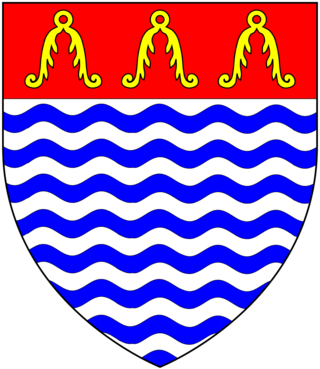
Bernard Smith of Totnes in Devon was MP for Totnes in 1558. He was mayor of Totnes in 1549–50 and c. 1565–6, and was escheator of Devon and Cornwall in 1567–8.

Ash in the parish of Braunton in North Devon is a historic estate listed in the Domesday Book. The present mansion, known as The Ash Barton estate is a Grade II* listed building.
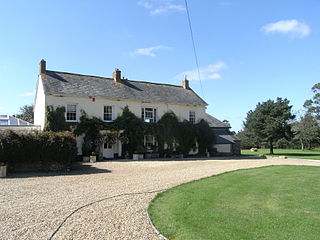
Way is a historic estate in the parish of St Giles in the Wood, Devon. It is situated about 2 miles (3.2 km) north-east of the village of St Giles in the Wood and about 4 miles (6.4 km) north-east of the town of Great Torrington. It was described by Hoskins (1959) as "the fons et origo of the mighty tribe of Pollard" and had been acquired by them from the de la Way family at some time before 1242.

Great Fulford is an historic estate in the parish of Dunsford, Devon. The grade I listed manor house, known as Great Fulford House, is about 9 miles west of Exeter. Its site was said in 1810 to be "probably the most ancient in the county". The present mansion house is Tudor with refurbishment from the late 17th century and further remodelling from about 1800. The prefix "Great" dates from the late 17th century and served to distinguish it from the mansion house known as "Little Fulford" in the parish of Shobrooke, Devon, about 8 miles to the north-east, also owned briefly by Col. Francis Fulford (1666–1700), as a result of his marriage to the heiress of the Tuckfield family. Great Fulford has been the residence of the Fulford family, which took its name from the estate, from the reign of King Richard I (1189–1199) to the present day. There are thus few, if any, families in Devonshire of more ancient recorded origin still resident at their original seat. In 2004 the estate comprised 3,000 acres.

Peamore is a historic country estate in the parish of Exminster, Devon, which is near the city of Exeter. In 1810 Peamore House was described as "one of the most pleasant seats in the neighbourhood of Exeter". The house was remodelled in the early 19th century and is now a grade II listed building.

Sir William Huddesfield of Shillingford St George in Devon, was Attorney General for England and Wales to Kings Edward IV (1461–1483) and Henry VII (1485–1509). He built the tower of St George's Church, Shillingford.

Sir Robert Spencer "of Spencer Combe" in the parish of Crediton, Devon, was the husband of Eleanor Beaufort (1431–1501), the daughter of Edmund Beaufort, 2nd Duke of Somerset (1406–1455), KG, and was father to two daughters and co-heiresses who made notable marriages.
The Manor of Clovelly is a historic manor in North Devon, England. Within the manor are situated the manor house known as Clovelly Court, the parish church of All Saints, and the famous picturesque fishing village of Clovelly. The parish church is unusually well-filled with well-preserved monuments to the lords of the manor, of the families of Cary, Hamlyn, Fane, Manners and Asquith. In 2015 the Rous family, direct descendants via several female lines of Zachary Hamlyn (1677–1759) the only purchaser of Clovelly since the 14th century, still own the estate or former manor, amounting to about 2,000 acres, including Clovelly Court and the advowson of the parish church, and the village of Clovelly, run as a major tourist attraction with annual paying visitor numbers of about 200,000.

Hawkridge in the parish of Chittlehampton in North Devon, England, is an historic estate, anciently the seat of a junior branch of the Acland family which originated at nearby Acland, in the parish of Landkey and later achieved great wealth and prominence as the Acland Baronets of Killerton, near Exeter. The former mansion house is today a farmhouse known as Hawkridge Barton, a grade II* listed building. The Devon historian Hoskins (1959) stated of Hawkridge: "Externally there is nothing remarkable except a decaying avenue of ancient walnuts, so often the first indication of a 16th or 17th century mansion". The interior contains a fine plaster heraldic overmantel showing the arms of Acland impaling Tremayne, representing the 1615 marriage of Baldwin Acland (1593–1659) of Hawkridge and Elizabeth Tremayne.

Upcott is an historic manor in the parish of Cheriton Fitzpaine, Devon. The manor house, known as Upcott Barton is a mediaeval grade II* listed building notorious in the history of Devon as the place where in 1455 the murder of the lawyer Nicholas Radford by a mob directed by the Earl of Devon during the Wars of the Roses took place. In the grounds is a reproduction of an Iron Age roundhouse built circa 2014.
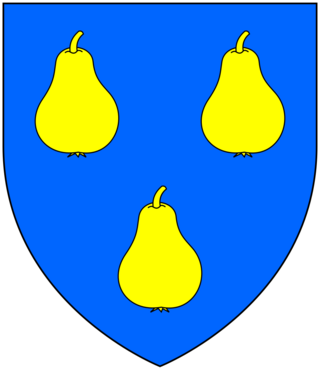
Sir Hugh Stucley (1496–1559) was the lord of Affeton in Devon, and Sheriff of Devon in 1545. His third son was Thomas Stukley, known as "The Lusty Stucley".
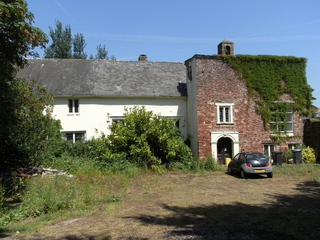
Blagdon historically in the parish of Paignton in Devon, England (today in the parish of Collaton St Mary), is a historic Manor, the seat of the Kirkham family from the 13th to 17th centuries. The manor house known as Blagdon Manor (House) (or Blagdon Barton) survives as a grade II* listed building about two miles west of the historic centre of the town of Paignton, situated behind the "Blagdon Inn" public house (former stables), and almost surrounded by the "Devon Hills Holiday Park" of caravans and mobile homes, set-back at the end of a short driveway off the A385 Paignton to Totnes road. The settlements or farms of Higher Blagdon, Middle Blagdon and Lower Blagdon are situated to the north of the manor house.

Ambrose Bellot, of Downton in Devon was a Member of Parliament for East Looe in Cornwall in 1597.
Thorne in the parish of Ottery St Mary in Devon is an historic estate situated on the west side of the River Otter opposite the town of Ottery St Mary. The site is today occupied by Thorne Farm situated to the immediate north of the town's school and hospital and to the immediate south of the surviving early 17th century grand mansion house of Cadhay.
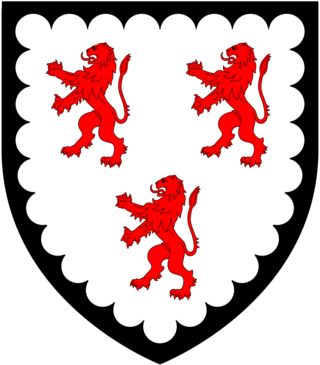
Sir John Kirkham (1472–1529) of Blagdon in the parish of Paignton, Devon, was Sheriff of Devon in 1523/4. He was one of the Worthies of Devon of the Devonshire biographer Prince (d.1723), who called him a "very free and liberal, ... prudent and discreet" benefactor of the town of Honiton in Devon.





